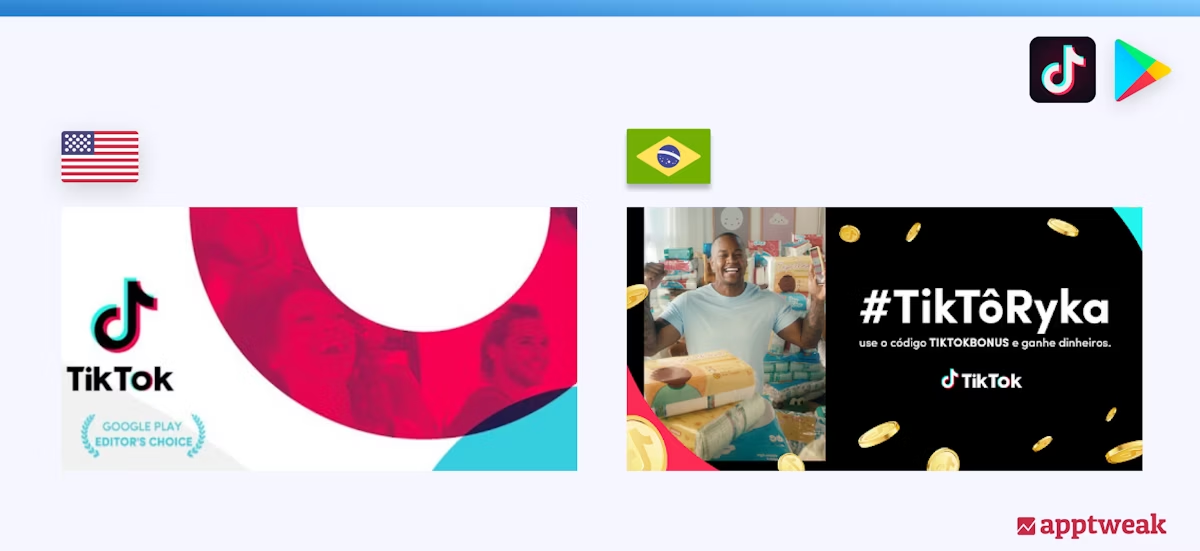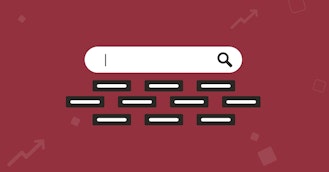
ブラジルポルトガル語でアプリをローカライズする方法
2020年に21.8億ドルの収益を上げたブラジルは、主要なラテンアメリカ経済国です。また、世界で13番目に大きいゲーム市場でもあります。ここで成功するには、アプリとゲームをブラジルポルトガル語にローカライズすることが不可欠です。このブログでは、ブラジルでアプリ/ゲームを成功裏にローカライズするための簡潔で実践的なヒントを提供します。
ブラジルにおけるモバイル市場の状況
iOS対Google Play
ブラジルでは、スマートフォンユーザーの83%以上がAndroidがモバイル市場を支配しています。高額な税金により、多くのブラジル人にとってAppleデバイスは費用が高すぎるため、彼らは手頃な価格のAndroidスマートフォンを好みます。
しかし、iOSユーザーはアプリ内購入により多く費やす傾向があります。
したがって、ブラジルでアプリをリリースする際は、Androidを優先しつつ、iOSも対象に含めるようにしてください。
人気のアプリ&ゲーム
ブラジルでは、ローカライズされたアプリとゲームがトップチャートを独占しています。実際、トップチャートを見ると、メタデータとクリエイティブの両方をブラジル市場向けにローカライズしたアプリやゲームがほとんどです。
アプリの好みに関して、ブラジル人はエンターテイメント、写真&ビデオ、ソーシャルネットワーキングアプリをより好む傾向があります。これらのカテゴリは現在、開発者にとって最も多くのダウンロード数を生み出し、トップチャートを独占しています。
例えば、App Storeの無料アプリトップ10のうち7つは、これらのカテゴリ(エンターテイメント、写真&ビデオ、またはソーシャルネットワーキング)の少なくとも1つに属しています。

ゲームはブラジルで非常に人気があります。ブラジルはゲーム収益14.5億ドルを誇る世界で13番目に大きいゲーム市場です。LocalizeDirectの2021年レポートによると、男性はアクション、レース、戦略、アドベンチャー、スポーツゲームを好み、ゲーマーの52.6%を占める女性は戦略、アドベンチャー、カード/トリビア、レースゲームを好む傾向があります。全体的に、戦略とアドベンチャーゲームがブラジルで最も人気のあるジャンルです。
言語
1. 長さ&アルファベット
ブラジルポルトガル語は一般的に多くのスペースを必要とする冗長な言語です。英語からテキストを翻訳する場合、ブラジルポルトガル語は25〜30%多くのスペースを必要とします。その結果、ブラジルポルトガル語の字幕やテキストダイアログ(もしあれば)を読むのにユーザーははるかに多くの時間を要するため、アプリ内およびゲーム内コンテンツを開発する際には、この点を考慮することが重要です。
英語とは異なり、ブラジルポルトガル語のアルファベットは多くの特殊文字で構成されています。したがって、
- セディーユ (ç)
- アキュートアクセント (á, é, í, ó, ú)
- サーカムフレックスアクセント (â, ê, ô)
- チルダ (ã, õ)
- グラーブアクセント (à、そして稀に è, ì, ò, ù)
ブラジルポルトガル語で文字が適切に実装されていない場合、単語全体の意味が変わる可能性があります。これはテキストの理解のギャップを引き起こす可能性があります。
2. ヨーロッパポルトガル語 vs ブラジルポルトガル語
ブラジルポルトガル語とヨーロッパポルトガル語が同じ言語であるという 誤解があります。
実際、それらは非常に異なります。スペル、発音、さらには単語全体が完全に変わることがよくあります。これは、ブラジル人が名詞から動詞を作り、表現を凝縮し、ブラジルポルトガル語の語彙がアフリカ系およびネイティブアメリカンの起源にも影響されているためです。
例えば、ブラジルではバスルームは「banheiro」と呼ばれますが、ポルトガルでは「sala de banhos」と呼ばれます。実際、ブラジルの市場参加者の大多数はヨーロッパポルトガル語のローカライズを拒否します。したがって、ブラジル市場向けにローカライズしたい場合は、ブラジルポルトガル語に特化してローカライズするか、まったくローカライズしないかのどちらかです。
3. ブラジルポルトガル語に翻訳する際の注意点
ブラジルのゲーマーにとって、直訳、意味不明な文章、文法ミス、または不適切な言葉遣いなど、ブラジルポルトガル語への不適切なローカライズは、体験を台無しにし、ゲーマーを英語に戻させる可能性があります。例えば、ブラジル市場向けにローカライズされたゲームは、しばしばリオデジャネイロのスラングや専門用語を使用することになります。
留意すべきは、これは地域的なスラングであり、全国的に使用されているわけではないため、避けるべきであるということです(ブラジルでは少なくとも16種類のポルトガル語が話されています)。したがって、実装するブラジルポルトガル語が全国的に受け入れられ、理解されるように、翻訳にはネイティブスピーカーと協力することが重要です。
また、常にゲーマーに英語またはブラジルポルトガル語でプレイするオプションを提供することを推奨します。

アプリストアのローカライズに関するこの包括的なガイドで、アプリのダウンロード数を増やしましょう
メタデータのローカライゼーション
1. タイトル
アプリのタイトルに関して、英語または外国のブランド名は好評です。特にタイトルを翻訳する意味がない場合は、「クール」とさえ認識されることがあります。実際、Instagram、TikTok、Clash of Clans、Homescapesなどの人気国際ブランドは、ブラジルではタイトルに元の名前のみを使用しています。
しかし、一部のケース(特にGoogle Play)では、タイトルにブランド名の後にいくつかの説明的なキーワードが追加されます。特にアプリの場合です。例えば、Google MeetとAliExpressは米国のGoogle Play Storeではブランド名のみを含んでいますが、ブラジルでは、アプリが何であるかをさらに説明するために、ブランド名の後にいくつかのローカライズされたキーワードを追加しています。

2. サブタイトル/短い説明(文)
ブラジル市場に参入する際、特にタイトルをブラジルポルトガル語に翻訳しても意味が通じない場合や、アプリの内容が伝わらない場合は、アプリのサブタイトル(またはGoogle Playでの短い説明(文))を翻訳してください。
例えば、米国の出会い系アプリCoffee Meets Bagelの場合、アプリのタイトルはアプリの内容を説明しておらず、ブラジルポルトガル語に翻訳しても意味が通じません。この場合、アプリがこの市場のために特別に作られたかのようにブラジルユーザーに感じさせ、アプリをより魅力的にするために、ローカライズされたサブタイトルを含めることが不可欠です。
3. キーワードフィールド/長い説明(文)
タイトルやサブタイトルとは異なり、iOSキーワードフィールド内の、通常特殊文字を含むキーワードは、必ずしも特殊文字で記述する必要はありません。
実際、時には特殊文字のない単語のバージョンが、元のバージョンと比較して良好な、あるいはより高い検索人気を持つことがあります(以下の例を参照)。それは、ブラジルユーザーが特殊文字のないキーボードを使用せずにストアを検索することがあるためです。
したがって、メタデータを選択する前に、特殊文字のあるキーワードとないキーワードのバージョンを確認することが重要です。

クリエイティブのローカライゼーション
ブラジルユーザーは、長い説明(文)よりもアプリのタイトル、サブタイトルまたは短い説明(文)、評価、クリエイティブを優先します。したがって、スクリーンショットはコンバージョン率において重要な役割を果たします。
1. スクリーンショット
季節性に合わせてスクリーンショットを調整する
- スクリーンショットをローカライズすることは、テキストメタデータとともに、ページビューからダウンロード数へのコンバージョンを損なわないために重要です。ブラジルでは、季節イベントに合わせてスクリーンショットを調整することが一般的です。しかし、ブラジルは主に南半球に位置するため、季節が異なることを覚えておいてください。例えば、ブラジルのクリスマスは暑く、7月の学校の休暇は北半球の国々とは異なり冬に当たります。したがって、クリエイティブやアプリ内/ゲーム内で季節イベントを理解し、正確に参照することが不可欠です。
- 多くのブラジルのアプリとゲームは、カーニバルやリオデジャネイロのパレードのような人気イベントに合わせてクリエイティブを更新します。Free Fireのようなゲームは、ブラジル市場向けに特別にゲーム内イベントを導入し、ホリデーテーマのアイテムを提供しています。
文化的な関連性に合わせてスクリーンショットを調整する
アプリやゲームをブラジルユーザー、特にゲーマーにとってより魅力的にするために、文化的な要素を取り入れ、スクリーンショットの背景を調整してください。
- カーニバルの衣装やモニュメント、ネイマールJrのような地元の人物といった文化的要素を、スクリーンショットとゲーム自体に組み込んでください。例えば、DDTank Mobileは コルコバード山とキリスト像をフィーチャーすることで、ブラジルでの最初のスクリーンショットを最適化しました。ゲームでは、カーニバルの衣装を含むローカライズされた服装のブラジル人プレイヤーも表示されました。

-
ブラジル向けにアプリのスクリーンショットをローカライズする際、モデルがブラジル人口を反映していることを確認してください。例えば、
Canva は、ヨーロッパポルトガル語のキャプションを避け、スクリーンショットのモデル、背景、コンテンツをブラジルポルトガル語に効果的に適応させました 。しかし、Canvaはスクリーンショットのアプリ内テキストをヨーロッパポルトガル語に翻訳しましたが、ブラジルポルトガル語への翻訳を見落とし、英語のままにしていました。

通貨、日付、測定値など、スクリーンショットの指標をローカライズすることは不可欠です。以下を使用することを検討してください:
- 24時間表示形式
- DD/MM/YYYYの日付形式
- 米ドル ($) よりもブラジルレアル (R$)
例えば、AliExpressはスクリーンショットのキャプションをブラジルポルトガル語に翻訳しましたが、通貨のローカライズを怠りました。対照的に、Wishは通貨とアプリ内テキストを含むすべてのスクリーンショットコンテンツをローカライズしました。
2. フィーチャーグラフィック
ブラジル人はソーシャルネットワーク、コンテスト、プロモーション、魅力的な取引を楽しんでいます。
- ソーシャルメディアを通じて、ユーザーにアプリを友人と共有するよう促してください。プロモーションと特別オファーを提供してください(通貨をブラジルレアル (R$) に変換することを忘れないでください)。
- これを達成するために、プロモーションテキストとGoogle Playのフィーチャーグラフィックを活用してください。例えば、TikTokは、ブラジルのミーム「#TikTokRyka」を使用したフィーチャーグラフィックで、「コードTIKTOKBONUSを使用して稼ぐ」という特別オファーを宣伝しました。
この方法は動画のあるアプリにのみ有効です。ストアリスティングでは動画のないアプリのフィーチャーグラフィックは表示されないためです。

ブラジル向けにアプリをローカライズするためのボーナスヒント
1. アプリのダウンロードサイズを調整する
ほとんどのブラジル人が低ストレージ(2〜4GB)の手頃なデバイスを好むため、それに応じてアプリやゲームを最適化することが不可欠です。4GがWi-Fiよりも普及しているため、ブラジル人はしばしばアプリのLITE版を好みます。
アプリの場合はAPKインストールサイズを40MB未満に、ゲームの場合は64MB未満に減らすことを目指し、オフラインまたは弱いネットワーク接続でも機能することを保証してください。
2. アプリの価格設定に注意する
アプリやゲームの価格設定では、最も近い90セントまたは99セントに丸めてください。これはブラジルで一般的な慣行です。
覚えておいてください、ブラジルのGoogle Playは税込み価格をサポートしています。したがって、価格がVATを含むすべての税金を考慮していることを確認してください。
3. 敏感なトピックを避ける
ブラジル人、特に若い層は、一般的に敏感なトピックに対して寛容さを示します。
しかし、人種差別や差別を含むテーマは、否定的な反応を引き起こす可能性があります。性的なトピックは、女性の客体化が頻繁に示唆されるため、議論の的となる可能性があり、これはブラジルの主に女性で構成されるゲームコミュニティにおいて懸念される点です。
したがって、これらの主題を避けることが賢明です。自殺、過度の暴力、または残虐性を表示すると、アプリストアでの禁止につながる可能性があります。例えば、モータルコンバットやDoomのようなゲームは、過度に暴力的で残虐なシーンを表示したため、以前ブラジルで禁止されました。
AppTweakがアプリのローカライズにどのように役立つかについて詳しく知りたい場合は、7日間の無料トライアルを開始してください!







 Lina Danilchik
Lina Danilchik

 Elizabeth Devine
Elizabeth Devine

 Ian Pernia
Ian Pernia